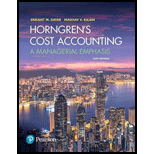
Revenue allocation, bundled products. Boca Resorts (BR) operates a five-star hotel with a world-class spa. BR has a decentralized management structure, with three divisions:
- Lodging (rooms, conference facilities)
- Food (restaurants and in-room service)
- Spa
Starting next month, BR will offer a two-day, two-person “getaway package” for $1,000. This deal includes the following:
| As Priced Separately | |
| Two nights’ stay for two in an ocean-view room | $ 750 ($375 per night) |
| Two spa treatments (can be used by either guest) | 300 ($150 per treatment) |
| Candlelight dinner for two at BR’s finest restaurant | 200 ($100 per person) |
| Total package value | $1,250 |
Jennifer Gibson, president of the spa division, recently asked the CEO of BR how her division would share in the $1,000 revenue from the getaway package. The spa was operating at 100% capacity. Currently, anyone booking the package was guaranteed access to a spa appointment. Gibson noted that every “getaway” booking would displace $300 of other spa bookings not related to the package. She emphasized that the high demand reflected the devotion of her team to keeping the spa rated one of the “Best 10 Luxury Spas in the World” by Travel Monthly. As an aside, she also noted that the lodging and food divisions had to turn away customers during only “peak-season events such as the New Year’s period.”
- 1. Using selling prices, allocate the $1,000 getaway-package revenue to the three divisions using:
- a. The stand-alone revenue-allocation method
- b. The incremental revenue-allocation method (with spa first, then lodging, and then food)
- 2. What are the pros and cons of the two methods in requirement 1?
- 3. Because the spa division is able to book the spa at 100% capacity, the company CEO has decided to revise the getaway package to only include the lodging and food offerings shown previously. The new package will sell for $800. Allocate the revenue to the lodging and food divisions using the following:
- a. The Shapley value method
- b. The weighted Shapley value method, assuming that lodging is three times as likely to sell as the food
Want to see the full answer?
Check out a sample textbook solution
Chapter 15 Solutions
Horngren's Cost Accounting: A Managerial Emphasis (16th Edition)
- Yield on the bond if it can be purchased for 1500?arrow_forwardA $2,000 bond issued in 2018 pays $180 in interest each year. What is the current yield on the bond if it can be purchased for $1,500?arrow_forwardUnit sales anticipated for April are 6,000; sales for May are 5,500; and sales for June are 9,500. Finished goods are consistently maintained at 75% of the following month's sales. If units cost $12 each to produce, how much is May's total cost of production? a) $0 b) $60,000 c) $82,500 d) $102,000 e) None of thesearrow_forward
 Managerial Accounting: The Cornerstone of Busines...AccountingISBN:9781337115773Author:Maryanne M. Mowen, Don R. Hansen, Dan L. HeitgerPublisher:Cengage Learning
Managerial Accounting: The Cornerstone of Busines...AccountingISBN:9781337115773Author:Maryanne M. Mowen, Don R. Hansen, Dan L. HeitgerPublisher:Cengage Learning Cornerstones of Cost Management (Cornerstones Ser...AccountingISBN:9781305970663Author:Don R. Hansen, Maryanne M. MowenPublisher:Cengage Learning
Cornerstones of Cost Management (Cornerstones Ser...AccountingISBN:9781305970663Author:Don R. Hansen, Maryanne M. MowenPublisher:Cengage Learning

